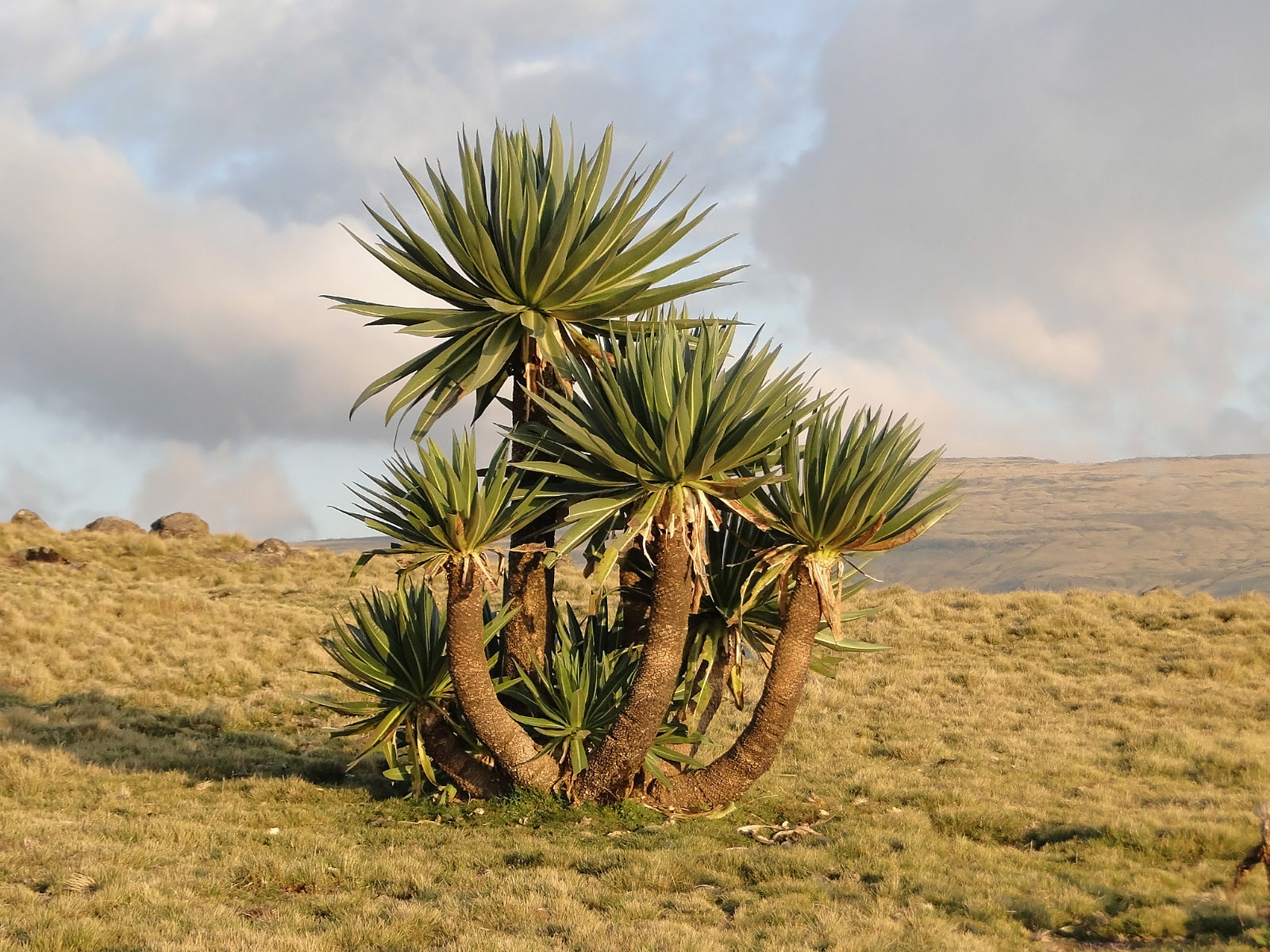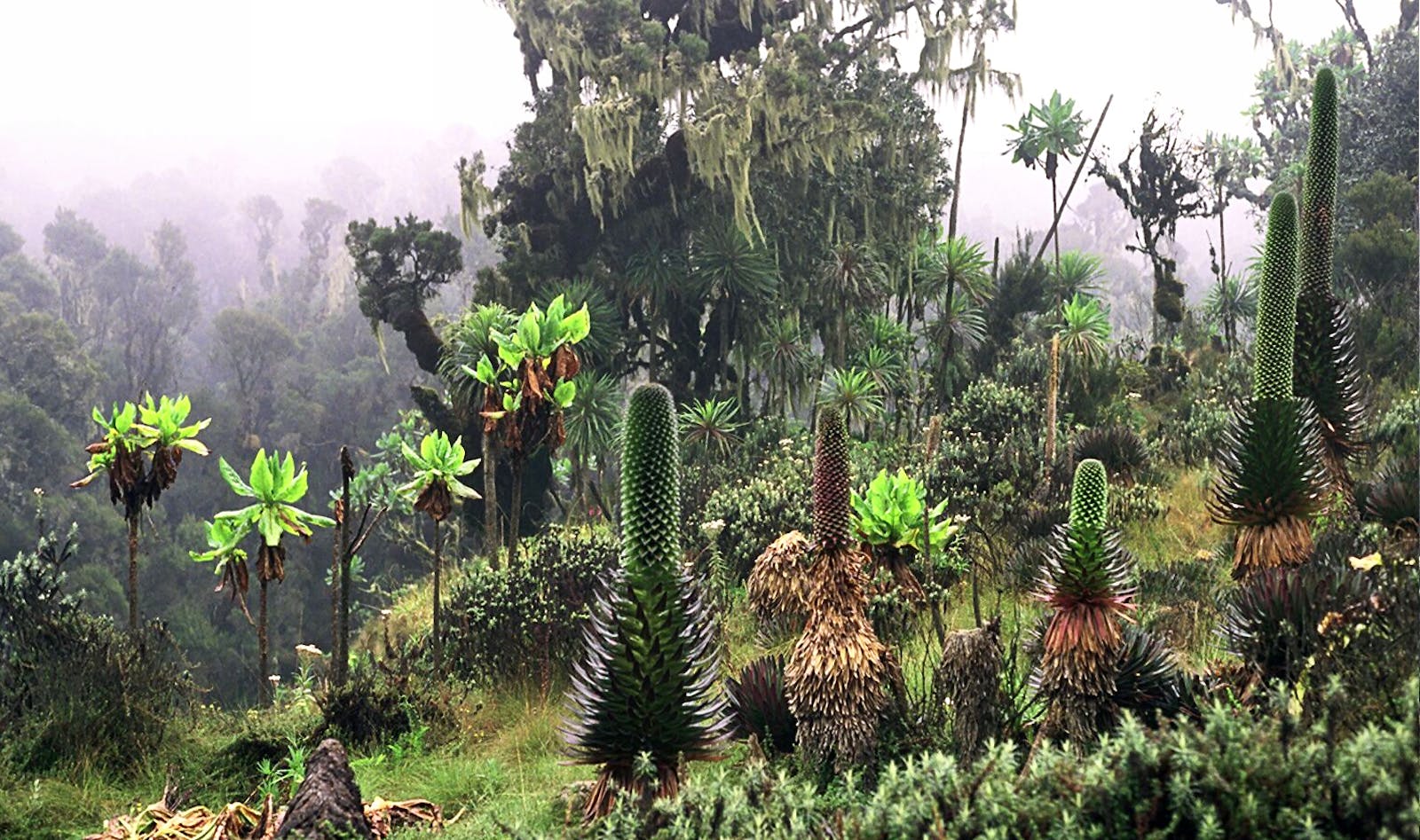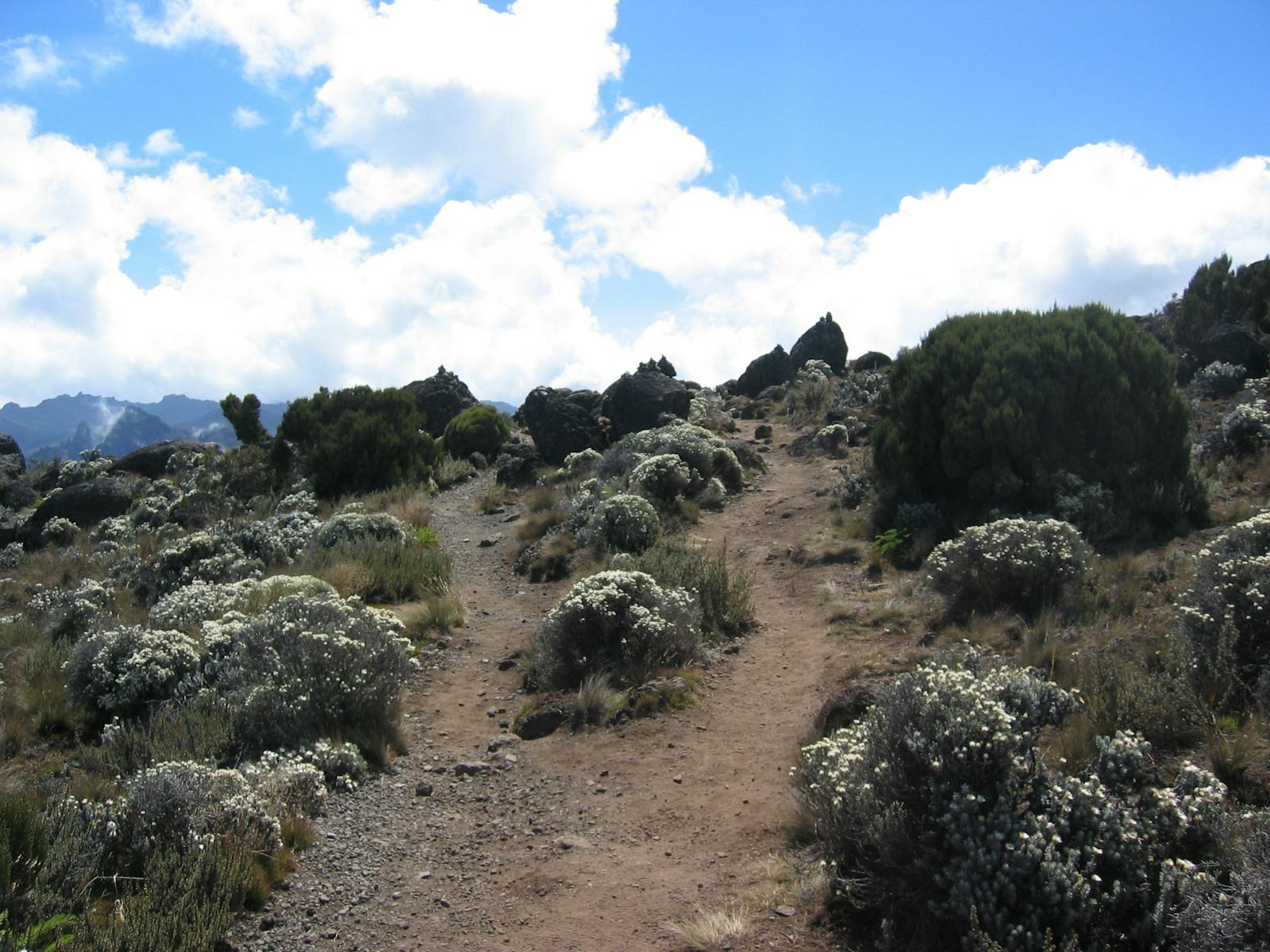East African Montane Moorlands
The ecoregion’s land area is provided in units of 1,000 hectares. The conservation target is the Global Safety Net (GSN1) area for the given ecoregion. The protection level indicates the percentage of the GSN goal that is currently protected on a scale of 0-10. N/A means data is not available at this time.
Bioregion: Lake Turkana-Sudd Grasslands, Bushlands & Forests (AT21)
Realm: Afrotropics
Subrealm: Horn of Africa
Ecoregion Size (1000 ha):
311
Ecoregion ID:
78
Conservation Target:
99%
Protection Level:
9
States: Kenya, Tanzania, Uganda
The mountains of East African Montane Moorlands have a severe climate with extreme and rapid fluctuations, best expressed as “summer every day and winter every night.” Rainfall is also low. On Mount Kilimanjaro, the highest peak in Africa, the mean rainfall is only 150 mm per annum above 4,350 m; at 5,000 m, the mean annual temperature is -1°C. Many plant species have developed characteristic protective measures against these harsh conditions; for example both Dendrosenecio and Lobelia have giant leaf rosettes which provide thermal insulation by closing at night.
The ecoregion occupies the peaks of large mountains close to the equator in Kenya, northernmost Tanzania, and the border area between Kenya and Uganda. The lower altitudinal limit for the moorland ecoregion is at the transition from the East African Montane Forests ecoregion, at around 3,000 m. These mountains are all volcanic in origin. The oldest, Mount Elgon, is 25 million years old, whereas Mount Kilimanjaro (5,895 m), Mount Kenya, the Aberdares, and Mount Meru are all much younger (2 to 5 million years old).

The giant lobelia (Lobelia rhynchopetalum) is the flagship species of the East African Montane Moorlands ecoregion. Image credit: Courtesy of Bernard Gagnon
Glaciers and snowfields are present on Kilimanjaro and Mount Kenya, although they are retreating. Rainfall (or snowfall at higher altitudes) has two peaks, one in April and the other from November to December. Daily nocturnal frosts occur above 4,000 m altitude. These mountains contribute significantly to the hydrology of the broader region. Above the tree line, montane moorland dominates and at the highest elevations, glaciers and rocks dominate.
Dendrosenecios are scattered through grasslands from 3,500 m to the vegetation limit at 5,000 m. Tussock grasslands are found in fire-prone or dry areas. Helichrysum scrub is found mainly on dry and rocky locations. Acaidic mires are found at lower altitudes in places where water can accumulate. Above 4,350 m on Mount Kilimanjaro, a montane desert with few plant species is found.
Floristically, this ecoregion is part of the Afroalpine archipelago-like region of extreme floristic impoverishment, with low diversity but high rates of endemism, notably among the plants and invertebrates. Numbers of endemic plant species vary between the different mountain blocks, ranging from two on Mount Meru to six on Mount Kilimanjaro to sixteen on Mount Elgon. Some examples include the giant lobelia, the giant groundsels Dendrosenecio keniensis, and Impatiens kilimanjari.
The number of vertebrate species is low and there are few endemics. Among the avifauna, there are no strict endemic species. There are, however, species that exhibit biogeographic distributions similar to those on islands. For example, Hunter’s cisticola is found between 1,500 and 4,500 m altitude on all mountaintops within this ecoregion. Two other species, Jackson’s francolin and Sharpe’s pipit occur on the northern three mountains, but not on Mount Meru and Mount Kilimanjaro to the south.
Reptiles and amphibians are adapted to survive the cold and unpredictable climate. There are two strictly endemic amphibians (Kenya River Frog and Kinangop River Frog), and near-endemics such as the high montane specialists Marsabit clawed frog and mountain reed frog. There are also a number of strict and near-endemic reptiles, such as alpine meadow lizard, Kenya montane viper, and Mount Kenya dwarf chameleon.
This ecoregion is naturally scattered across the few suitable high mountaintops in East Africa. Much of the ecoregion is found in national parks, for example Mount Kenya and Aberdare National Parks in Kenya, and Arusha and Kilimanjaro National Parks in Tanzania. The Ugandan side of Mount Elgon is also a national park. The Kenyan side is protected by Chepkitale National Reserve and Mount Elgon National Park.
The ecoregion is found at very high altitudes that are not suitable for farming and is mainly located within protected areas. Fire has, however, become a huge problem, with large areas of the heathland burning each year, which is thought to have depressed the upper limit of forest and removed stands of heath vegetation. This is changing the vegetation structure, causing the loss of heath species and their replacement by pioneer grass species. In the past 16 years, 33% of the alpine moorland areas on Mount Kenya have been burnt.
The incidence of fire has been linked to dramatic increases in the numbers of tourists walking in these mountains, as have other problems such as littering, erosion, and the cutting of woody vegetation to make fires. Tourism activities lead to pollution, for example the dumping of rubbish on Mount Kilimanjaro. A growing threat is from climate change and the impacts have already been seen; glaciers have been significantly retreating. On Mount Kilimanjaro, the ice cap is predicted to disappear by 2020 if the current rates of retreat continue. This would be the first time in 11,000 years.
Priority conservation actions for the next decade:
- Support community participation in ecotourism activities through capacity building on ecotourism techniques which promote local culture and protect natural resources.
- Effectively manage wildfires and control intentional fires through fire management plans.
- Implement and enforce pollution and litter management plans.
-
-
1. Burgess, N., Hales, J.A., Underwood, E., Dinerstein, E., Olson, D., Itoua, I., Schipper, J., Ricketts, T. and Newman, K. 2004. Terrestrial ecoregions of Africa and Madagascar: a conservation assessment. Island Press.
2. CEPF. 2012. Ecosystem Profile: Eastern Afromontane Biodiversity Hotspot. [Online]. [Accessed 9 March 2018]. Available from: https://www.cepf.net/sites/default/files/eastern_afromontane_ecosystem_profile_final.pdf
3. Mgonja, J.T., Sirima, A. and Mkumbo, P.J. 2015. A review of ecotourism in Tanzania: magnitude, challenges, and prospects for sustainability. Journal of Ecotourism. 14(2-3), pp.264-277.
4. Downing, T.A., Imo, M. and Kimanzi, J. 2017. Fire occurrence on Mount Kenya and patterns of burning. GeoResJ. 13, pp.17-26. -
Cite this page: East African Montane Moorlands. Ecoregion Snapshots: Descriptive Abstracts of the Terrestrial Ecoregions of the World, 2021. Developed by One Earth and RESOLVE. https://www.oneearth.org/ecoregions/east-african-montane-moorlands/
-





